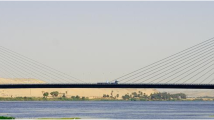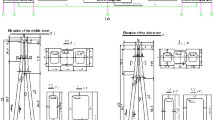Abstract
This paper presents a novel and precise seismic performance evaluation method for large-span offshore cable-stayed (LSOCS) bridge by considering the strain rate effect of RC materials and the spatial variation effect of seafloor seismic motions. Three-dimensional finite element (FE) model of a LSOCS bridge located in the southeast coast of China is constructed in the ABAQUS platform. The non-uniform ground motions at the offshore site beneath the bridge are stochastically simulated and used as seismic inputs. Moreover, a subroutine for considering the rate-dependent properties of RC materials in a fiber-based beam-column element model is developed to account for the strain rate effect of RC materials in the nonlinear time-history analysis. The numerical results indicate that seismic responses and fragilities of the LSOCS bridge are both considerably affected by the non-uniform seafloor seismic motions and strain rate effect. The seismic performance evaluation approach presented in this paper can provide vital support for earthquake resistant design of LSOCS bridges.
Similar content being viewed by others
References
Liu C, Zhang S, Hao E. Joint earthquake, wave and current action on the pile group cable-stayed bridge tower foundation: An experimental study. Appl Ocean Res, 2017, 63: 157–169
Li C, Li H N, Hao H, et al. Seismic fragility analyses of sea-crossing cable-stayed bridges subjected to multi-support ground motions on offshore sites. Eng Struct, 2018, 165: 441–456
Hao H, Oliveira C S, Penzien J. Multiple-station ground motion processing and simulation based on SMART-1 array data. Nucl Eng Des, 1989, 111: 293–310
Kiureghian A D. A coherency model for spatially varying ground motions. Earthq Eng Struct Dyn, 1996, 25: 99–111
Deodatis G. Non-stationary stochastic vector processes: Seismic ground motion applications. Probab Eng Mech, 1996, 11: 149–167
Zerva A, Zervas V. Spatial variation of seismic ground motions: An overview. Appl Mech Rev, 2002, 55: 271–297
Bi K, Hao H. Modelling and simulation of spatially varying earthquake ground motions at sites with varying conditions. Probab Eng Mech, 2012, 29: 92–104
Zhang D Y, Liu W, Xie W C, et al. Modeling of spatially correlated, site-reflected, and nonstationary ground motions compatible with response spectrum. Soil Dyn Earthq Eng, 2013, 55: 21–32
Harichandran R S, Hawwari A, Sweidan B N. Response of long-span bridges to spatially varying ground motion. J Struct Eng, 1996, 122: 476–484
Zanardo G, Hao H, Modena C. Seismic response of multi-span simply supported bridges to a spatially varying earthquake ground motion. Earthq Eng Struct Dyn, 2002, 31: 1325–1345
Kim S H, Feng M Q. Fragility analysis of bridges under ground motion with spatial variation. Int J Non-Linear Mech, 2003, 38: 705–721
Soyluk K, Sicacik E A. Soil-structure interaction analysis of cable-stayed bridges for spatially varying ground motion components. Soil Dyn Earthq Eng, 2012, 35: 80–90
Li C, Hao H, Li H, et al. Seismic fragility analysis of reinforced concrete bridges with chloride induced corrosion subjected to spatially varying ground motions. Int J Str Stab Dyn, 2016, 16: 1550010
Li C, Hao H, Li H, et al. Theoretical modeling and numerical simulation of seismic motions at seafloor. Soil Dyn Earthq Eng, 2015, 77: 220–225
Boore D M, Smith C E. Analysis of earthquake recordings obtained from the Seafloor Earthquake Measurement System (SEMS) instruments deployed off the coast of southern California. Bull Seismol Soc Amer, 1999, 89: 260–274
Chen B, Wang D, Li H, et al. Characteristics of earthquake ground motion on the seafloor. J Earthq Eng, 2015, 19: 874–904
Li C, Hao H, Li H, et al. Modeling and simulation of spatially correlated ground motions at multiple onshore and offshore sites. J Earthq Eng, 2017, 21: 359–383
Li C, Li H N, Hao H, et al. Simulation of spatially varying seafloor motions using onshore earthquake recordings. J Eng Mech, 2018, 144: 04018085
Li C, Li H, Hao H, et al. Simulation of multi-support depth-varying earthquake ground motions within heterogeneous onshore and offshore sites. Earthq Eng Eng Vib, 2018, 17: 475–490
Bischoff P H, Perry S H. Compressive behaviour of concrete at high strain rates. Mater Struct, 1991, 24: 425–450
Fu H C, Erki M A, Seckin M. Review of effects of loading rate on reinforced concrete. J Struct Eng, 1991, 117: 3660–3679
Soroushian P, Choi K. Steel mechanical properties at different strain rates. J Struct Eng, 1987, 113: 663–672
Li H N, Liu P F, Li C, et al. Experimental research on dynamic mechanical properties of metal tailings porous concrete. Constr Build Mater, 2019, 213: 20–31
Li H N, Li M. Experimental and numerical study on dynamic properties of RC beam. Mag Concrete Res, 2013, 65: 744–756
Wang D, Li H N, Li G. Experimental study on dynamic mechanical properties of reinforced concrete column. J Reinf Plast Comp, 2013, 32: 1793–1806
Wang D, Li H N, Li G. Experimental tests on reinforced concrete columns under multi-dimensional dynamic loadings. Constr Build Mater, 2013, 47: 1167–1181
Li R H, Li H N, Li C. Dynamic modified model for RC columns based on experimental observations and bayesian updating method. J Eng Mech, 2019, 145: 04019005
Asprone D, Frascadore R, Di Ludovico M, et al. Influence of strain rate on the seismic response of RC structures. Eng Struct, 2012, 35: 29–36
Li R H, Li H N, Li C. Seismic performance assessment of RC frame structures subjected to far-field and near-field ground motions considering strain rate effect. Int J Str Stab Dyn, 2018, 18: 1850127
Zhang H, Li H N, Li C, et al. Experimental and numerical investigations on seismic responses of reinforced concrete structures considering strain rate effect. Constr Build Mater, 2018, 173: 672–686
Ministry of Construction China. Code for Design of Concrete Structures (in Chinese). GB 50010–2010. Beijing: China Architecture & Building Press, 2011
Clough R W, Penzien J. Dynamics of Structures. New York: McGraw Hill, 1993
Sobczky K. Stochastic Wave Propagation. Netherlands: Kluwer Academic Publishers, 1991
RP 2A-WSD. Recommended Practice for Planning, Designing and Constructing Fixed Offshore Platforms-Working Stress Design. Houston: American Petroleum Institute, 2000
Hibbitte K. ABAQUS User Subroutines Reference Manual. Dallas: HKS Inc., 2005
Malvar L J, Ross C A. Review of strain rate effects for concrete in tension. ACI Mater J, 1998, 95: 435–439
Yan D M. Experimental and theoretical study on the dynamic properties of concrete (in Chinese). Dissertation of Doctoral Degree. Dalian: Dalian University of Technology, 2006
Kent D C, Park R. Flexural members with confined concrete. J Struct Div, 1971, 97: 1969–1990
Esmaeily F C, Xiao Y. Behavior of reinforced concrete columns under variable axial loads: Analysis. ACI Struct J, 2005, 102: 736–744
Morison J R, Johnson J W, Schaaf S A. The force exerted by surface waves on piles. J Pet Tech, 1950, 2: 149–154
Zhang J, Huo Y. Evaluating effectiveness and optimum design of isolation devices for highway bridges using the fragility function method. Eng Struct, 2009, 31: 1648–1660
Nielson B G. Analytical fragility curves for highway bridges in moderate seismic zones. Dissertation of Doctoral Degree. Atlanta: Georgia Institute of Technology, 2005
Cornell C A, Jalayer F, Hamburger R O, et al. Probabilistic basis for 2000 SAC federal emergency management agency steel moment frame guidelines. J Struct Eng, 2002, 128: 526–533
Author information
Authors and Affiliations
Corresponding author
Additional information
This work was supported by the National Natural Science Foundation of China (Grant No. 51808099) and the Fundamental Research Funds for the Central Universities (Grant No. DUT20RC(3)005).
Rights and permissions
About this article
Cite this article
Li, C., Li, H., Zhang, H. et al. Seismic performance evaluation of large-span offshore cable-stayed bridges under non-uniform earthquake excitations including strain rate effect. Sci. China Technol. Sci. 63, 1177–1187 (2020). https://doi.org/10.1007/s11431-020-1651-4
Received:
Accepted:
Published:
Issue Date:
DOI: https://doi.org/10.1007/s11431-020-1651-4




